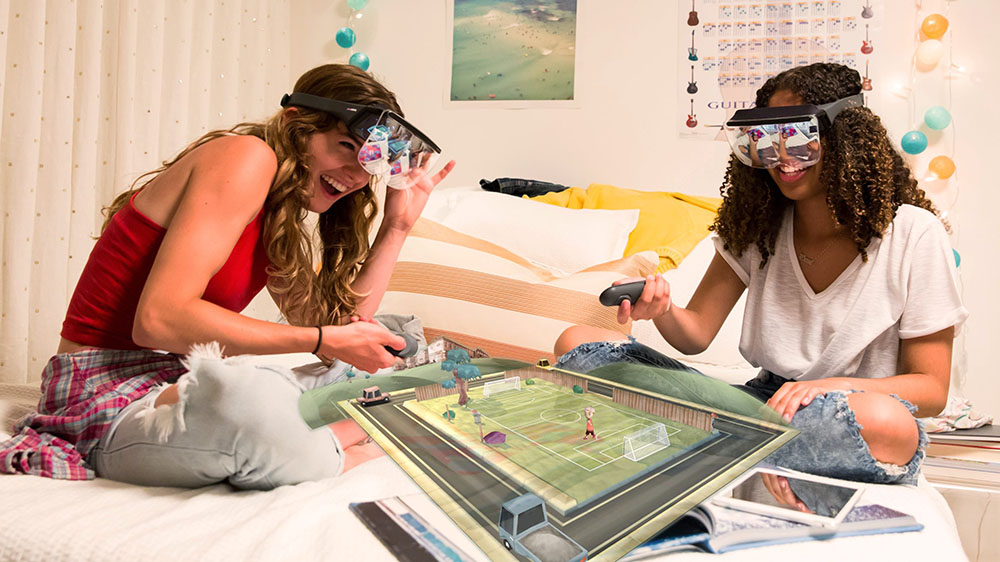Augmented reality start-up Mira debuted its new Prism smart glasses to attendees at VR Con at San Diego Comic-Con over the weekend. The untethered headset will launch this fall and work with Apple iPhones. It will come bundled with a remote control and a suite of games and apps. It’s currently available for pre-order at $99 and will be sold at retail for $149.
Users open an app on their iPhone, slide the phone into the Prism headset and begin exploring interactive holographic content. Prism’s clear lenses enable users to remain present, setting the Mira experience apart from the isolation inherent in portable VR headsets.
“We’re guaranteeing about a dozen AR apps from games to web browsers and 3D design tools at launch,” Ben Taft, co-founder and CEO of Mira, told AListDaily. “We’re also allowing third-party developers to publish their own apps in the app store, some of which will be free and others will be available for purchase.”
Mira has partnered with immersive content studios, including Funktronic Labs, Big Red Button Entertainment and Fuzzy Logic, to create an initial suite of AR experiences for developers to learn from and consumers to play. These experiences range from solo challenges to multiplayer games, including mixed-reality puzzles, holographic chess and digital warship battles. The remote tracks acceleration and rotation and includes a touchpad, trigger and two buttons; it can be used as a fishing rod, laser pointer, paintbrush, steering wheel and magic wand.
“These are studios that have built a handful of VR and AR experiences that we fell in love with, so we reached out to them and asked them to be part of this program with us,” Taft said. “We’ve been working with them to create this first wave of experiences and really shape the platform together.”
Outside of its mass market price point, Prism is marketing its Spectator Mode, which allows users to collaborate and explore in AR. This feature also allows anyone to record video or capture photos of their friends’ experience and share via social media across iPhones and iPads.
“AR is inherently social and inherently shareable, especially with the feature that we built that allows you to share your experience in real-time with someone else, or the fact that you and I can both put on a headset and share an experience together,” Taft said. “That sort of social nature and viral nature allows people to really understand the experience outside of just trying it. They can join in even without a headset, and that shareable aspect of Prism is going to let more people understand the experience before putting on the headset.”
This social and viral component is something Prism is opening up to brands.
“A lot of brands we’re in talks with right now are interested in this shareable component,” Taft explained. “We have an amazing studio pipeline set up so brands that are interested can come to us and we have a handful of vetted 3D content studio partners who are already familiar with our software and the headset, and we pair them with the brand and help them create an experience on top of our platform.”
Mira recently raised $1.5 million in seed funding from Sequoia Capital, Troy Capital Partners, S-Cubed Capital, Salesforce CEO Marc Benioff, Jaunt VR founder Jens Christensen and artist/tech investor will.i.am of the Black Eyed Peas.
will.i.am was at VR Con to announce that he invested in Mira because he’s going to incorporate AR into his 2018 global tour. Once AR becomes a part of a concert experience, this will open up new opportunities for brands to literally get into concertgoers’ faces, and also introduce new opportunities to reward fans through everything from sponsored content to contests.
Powered by the Unity 3D game engine, Mira is releasing a software developer kit, enabling creators to develop unique experiences or retool existing VR or gaming assets for use on the Prism headset. Taft said Prism Developer Editions will be sent to studios a few months before the consumer launch of the headset.
“Interested developers can create sophisticated, multiplayer experiences that extend interactions beyond the screen and can easily publish their work to a mass market reaching millions of mobile users,” Taft explained.
The recently announced Apple ARKit will allow developers to create content for Prism.
“ARKit is going to create a wave of experiences that anyone can look at through an iPhone,” Taft said. “It’s going to educate people on a mass scale about the difference between AR and VR. They’re going to understand virtual objects superimposed in the real world. You can imagine walking around outside and playing a game on your smartphone and then coming home and sliding it into the Prism and bringing that same experience more to life in the environment around you. We’re encouraging all our developers to think about how content lives both in the phone world and in the headset world, and more importantly how they interface with each other.”

